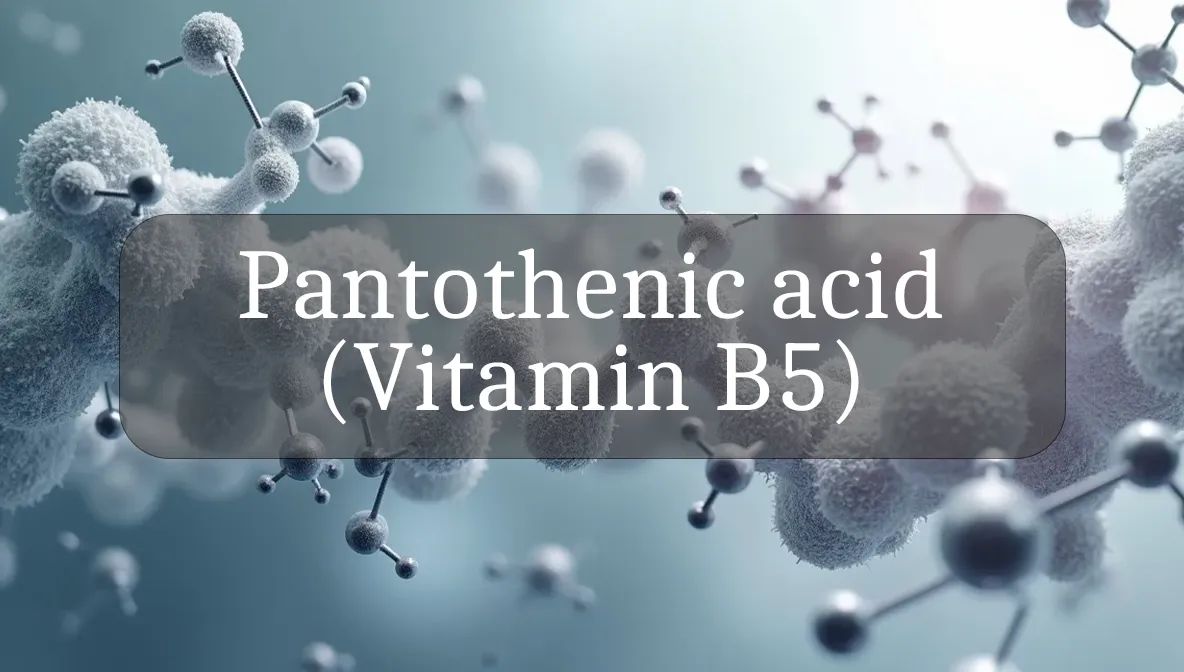Energy and Skin Health Booster
Pantothenic acid, also known as vitamin B5, is like your body’s multitasking fuel, a water-soluble vitamin that powers energy production, skin health, and countless metabolic processes. Found in a wide range of foods, it’s a key focus for health-conscious folks aiming to maintain vitality and resilience. Understanding pantothenic acid can empower you to make dietary choices that support your energy and wellness. Let’s explore what pantothenic acid is, why it matters, and how you can ensure adequate intake for daily vitality!
Chemical Identity and Type
Pantothenic acid (C₉H₁₇NO₅) is a B-complex vitamin, named from the Greek “pantos,” meaning “everywhere,” due to its widespread presence in foods. It’s a precursor to coenzyme A (CoA), a critical molecule in energy metabolism, and is also found as pantothenate or pantetheine in biochemical pathways. Synthesized by gut bacteria in small amounts, it’s primarily obtained through diet. Think of pantothenic acid as a spark plug, igniting metabolic reactions for energy and repair.
Biological Role and Benefits
Pantothenic acid is essential for cellular function, offering these evidence-based benefits:
- Energy Production: As part of CoA, it helps metabolize carbohydrates, fats, and proteins into energy (ATP), fueling every cell (e.g., supports Krebs cycle).
- Skin and Hair Health: It supports skin barrier function, wound healing, and sebum production, reducing acne and promoting healthy hair (studies show topical B5 improves hydration).
- Hormone and Cholesterol Synthesis: CoA aids in producing steroid hormones (e.g., cortisol) and cholesterol, supporting stress response and heart health.
- Red Blood Cell Formation: It contributes to heme synthesis, ensuring oxygen transport and preventing anemia.
- Nervous System Support: It helps synthesize acetylcholine, a neurotransmitter for memory and muscle function.
Adequate pantothenic acid levels keep you energized, skin glowing, and metabolism humming, enhancing overall vitality.
Dietary or Natural Sources
Pantothenic acid is abundant in many foods, making deficiency rare. Include these sources to meet the Recommended Dietary Allowance (RDA: 5 mg/day for adults):
- High B5 Foods:
- Chicken liver (7.8 mg/100 g)
- Beef liver (6.7 mg/100 g)
- Shiitake mushrooms (3.6 mg/100 g)
- Sunflower seeds (1.0 mg/28 g)
- Salmon (1.6 mg/100 g)
- Moderate B5 Foods:
- Eggs (1.5 mg/2 large eggs)
- Avocado (1.4 mg/medium)
- Whole grains (oats, brown rice; 0.5–1 mg/100 g)
- Broccoli (0.6 mg/100 g)
- Yogurt (0.4 mg/100 g)
- Fortified Foods: Some cereals and energy bars are fortified with B5 (check labels).
- Supplements: Available as pantothenic acid or calcium pantothenate (10–100 mg), though rarely needed due to dietary abundance.
A varied diet easily provides 4–7 mg/day, supporting optimal B5 levels.
Signs of Imbalance or Dysfunction
Pantothenic acid deficiency is extremely rare due to its widespread availability, but severe cases or imbalances may show up as:
- Deficiency Symptoms (often experimental or in malnutrition):
- Fatigue, irritability, or low energy from impaired energy metabolism.
- Burning feet syndrome (tingling, numbness in feet).
- Digestive issues like nausea or abdominal cramps.
- Insomnia, depression, or poor coordination.
- Skin issues like acne or dryness (less common).
- Excess B5 (Rare, >10 g/day from supplements):
- Mild diarrhea or stomach upset.
- Potential interference with biotin absorption (uncommon).
These symptoms are uncommon and can have many causes, so consult a healthcare provider if they persist to explore nutrient or health issues.
Supporting Optimal Levels or Function
To ensure adequate pantothenic acid intake and function, try these evidence-based tips:
- Eat a Varied Diet: Include liver, eggs, avocados, or mushrooms to naturally meet B5 needs without supplements.
- Cook Minimally: Lightly steam or sauté B5-rich vegetables (e.g., broccoli) to preserve water-soluble vitamin content, as boiling can leach up to 30% of B5.
- Balance Gut Health: Consume probiotic foods (yogurt, kefir) to support gut bacteria that produce small amounts of B5.
- Limit Alcohol and Processed Foods: Excessive alcohol or refined grains may deplete B vitamins, including B5, so moderate intake.
- Monitor Skin Health: Use topical B5 (panthenol) creams for acne or dry skin, as studies show 1–5% formulations improve hydration and healing.
Small, consistent habits ensure pantothenic acid supports your energy and skin health.
Safety, Interactions, and Precautions
Pantothenic acid is safe at dietary levels and even high supplemental doses (up to 10 g/day), but consider these factors:
- Malabsorption Conditions: Diseases like Crohn’s, celiac, or alcoholism may impair B5 absorption, though deficiency remains rare. Medical management is key.
- Medications: Oral contraceptives or antibiotics may slightly reduce B5 levels, but dietary intake typically compensates. Consult a healthcare provider if concerned.
- Allergies: Rare allergic reactions to B5 supplements (e.g., rash) may occur. Choose high-quality products and discontinue if symptoms appear.
- Excessive Supplementation: Doses >10 g/day may cause diarrhea or interact with other B vitamins (e.g., biotin). Stick to dietary sources or low-dose supplements (10–50 mg).
- Pregnancy and Breastfeeding: Safe at RDA levels (6–7 mg/day); no evidence of toxicity, but avoid high-dose supplements without medical guidance.
Moderation and a balanced diet maximize pantothenic acid’s benefits with minimal risk.
Fun Fact
Did you know pantothenic acid’s name comes from the Greek word for “everywhere”? It’s so common in foods that ancient diets likely provided plenty, making it one of the easiest vitamins to get naturally!
Citations
- National Institutes of Health (NIH): Pantothenic Acid Fact Sheet.
- Mayo Clinic: B Vitamins and Energy Metabolism.
- Cleveland Clinic: Nutrition and Skin Health.
- World Health Organization (WHO): Diet and Micronutrient Guidelines.
- USDA: Dietary Guidelines for Americans – Nutrient-Dense Diets.

